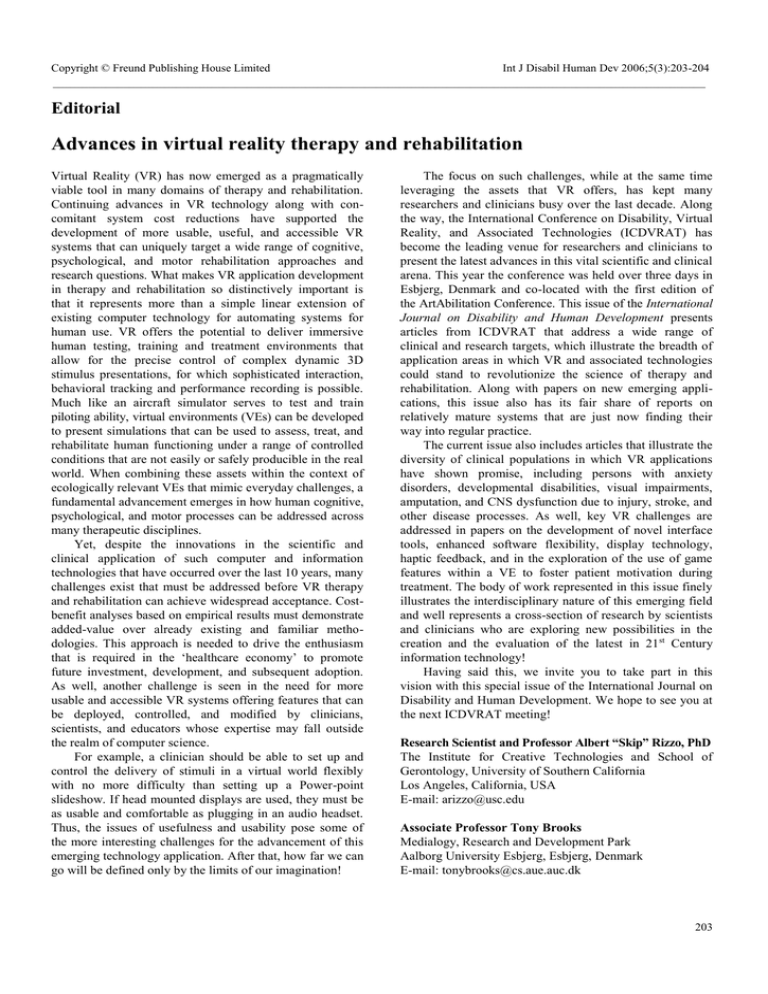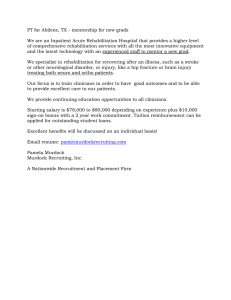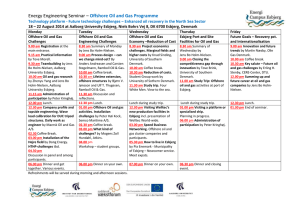IJDHD 5 3 2006 EDITORIAL FINAL
advertisement

Copyright © Freund Publishing House Limited Int J Disabil Human Dev 2006;5(3):203-204 _______________________________________________________________________________________________________________ Editorial Advances in virtual reality therapy and rehabilitation Virtual Reality (VR) has now emerged as a pragmatically viable tool in many domains of therapy and rehabilitation. Continuing advances in VR technology along with concomitant system cost reductions have supported the development of more usable, useful, and accessible VR systems that can uniquely target a wide range of cognitive, psychological, and motor rehabilitation approaches and research questions. What makes VR application development in therapy and rehabilitation so distinctively important is that it represents more than a simple linear extension of existing computer technology for automating systems for human use. VR offers the potential to deliver immersive human testing, training and treatment environments that allow for the precise control of complex dynamic 3D stimulus presentations, for which sophisticated interaction, behavioral tracking and performance recording is possible. Much like an aircraft simulator serves to test and train piloting ability, virtual environments (VEs) can be developed to present simulations that can be used to assess, treat, and rehabilitate human functioning under a range of controlled conditions that are not easily or safely producible in the real world. When combining these assets within the context of ecologically relevant VEs that mimic everyday challenges, a fundamental advancement emerges in how human cognitive, psychological, and motor processes can be addressed across many therapeutic disciplines. Yet, despite the innovations in the scientific and clinical application of such computer and information technologies that have occurred over the last 10 years, many challenges exist that must be addressed before VR therapy and rehabilitation can achieve widespread acceptance. Costbenefit analyses based on empirical results must demonstrate added-value over already existing and familiar methodologies. This approach is needed to drive the enthusiasm that is required in the ‘healthcare economy’ to promote future investment, development, and subsequent adoption. As well, another challenge is seen in the need for more usable and accessible VR systems offering features that can be deployed, controlled, and modified by clinicians, scientists, and educators whose expertise may fall outside the realm of computer science. For example, a clinician should be able to set up and control the delivery of stimuli in a virtual world flexibly with no more difficulty than setting up a Power-point slideshow. If head mounted displays are used, they must be as usable and comfortable as plugging in an audio headset. Thus, the issues of usefulness and usability pose some of the more interesting challenges for the advancement of this emerging technology application. After that, how far we can go will be defined only by the limits of our imagination! The focus on such challenges, while at the same time leveraging the assets that VR offers, has kept many researchers and clinicians busy over the last decade. Along the way, the International Conference on Disability, Virtual Reality, and Associated Technologies (ICDVRAT) has become the leading venue for researchers and clinicians to present the latest advances in this vital scientific and clinical arena. This year the conference was held over three days in Esbjerg, Denmark and co-located with the first edition of the ArtAbilitation Conference. This issue of the International Journal on Disability and Human Development presents articles from ICDVRAT that address a wide range of clinical and research targets, which illustrate the breadth of application areas in which VR and associated technologies could stand to revolutionize the science of therapy and rehabilitation. Along with papers on new emerging applications, this issue also has its fair share of reports on relatively mature systems that are just now finding their way into regular practice. The current issue also includes articles that illustrate the diversity of clinical populations in which VR applications have shown promise, including persons with anxiety disorders, developmental disabilities, visual impairments, amputation, and CNS dysfunction due to injury, stroke, and other disease processes. As well, key VR challenges are addressed in papers on the development of novel interface tools, enhanced software flexibility, display technology, haptic feedback, and in the exploration of the use of game features within a VE to foster patient motivation during treatment. The body of work represented in this issue finely illustrates the interdisciplinary nature of this emerging field and well represents a cross-section of research by scientists and clinicians who are exploring new possibilities in the creation and the evaluation of the latest in 21 st Century information technology! Having said this, we invite you to take part in this vision with this special issue of the International Journal on Disability and Human Development. We hope to see you at the next ICDVRAT meeting! Research Scientist and Professor Albert “Skip” Rizzo, PhD The Institute for Creative Technologies and School of Gerontology, University of Southern California Los Angeles, California, USA E-mail: arizzo@usc.edu Associate Professor Tony Brooks Medialogy, Research and Development Park Aalborg University Esbjerg, Esbjerg, Denmark E-mail: tonybrooks@cs.aue.auc.dk 203 204 EDITORIAL Professor Paul M Sharkey, HDipEE, BSc(Eng), MA, PhD Director of Research School of Systems Engineering University of Reading, Reading, United Kingdom E-mail: p.m.sharkey@reading.ac.uk Professor Joav Merrick, MD, MMedSci, DMSc Medical Director, Ministry of Social Affairs, Jerusalem Director, National Institute of Child Health and Human Development E-mail: jmerrick@zahav.net.il



